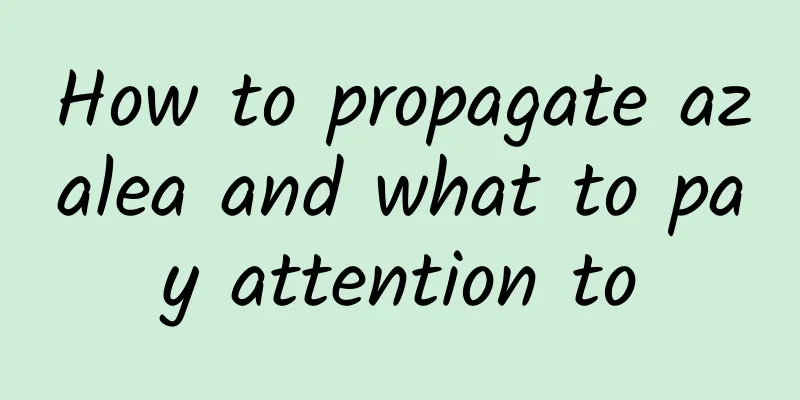How to propagate azalea and what to pay attention to

How to propagate azaleaThe ways to propagate azalea include cutting propagation, layering propagation, grafting propagation, and sowing propagation. Azalea seeds can be propagated, and the natural reproduction method is sowing propagation. Azalea cutting propagation is the fastest. Rhododendron breeding timeThe sowing time for azalea is in spring from March to April, and the cutting time is in early summer and late autumn. It is best not to propagate in winter and summer, which will affect rooting and make it difficult for the plants to survive. How to propagate azaleaRhododendron division propagationPeel the sturdy azalea mother plant into several branches, then plant them in pots on a moist, fertile substrate and maintain them in a semi-shaded environment. They will soon take root. Rhododendron cutting propagationRhododendron can be propagated by cuttings at any time in a warm environment, preferably in early summer and autumn. Choose river sand, vermiculite, and peat as the substrate, disinfect it in advance, select the branches that sprouted this year, trim the leaves at the base, and only keep the top 2-3 leaves. Then insert them into the soil, water them enough, provide appropriate shade, and cover them with a film to keep them moist. They will take root in 30 days. Rhododendron sowing propagationMost rhododendrons can bear fruit. From October to January of the following year, collect the seeds, place them in a ventilated and cool place to dry, and sow them in pots in March and April in spring. The seeds are small and can be evenly sprinkled in the soil. Cover them with a layer of glass or plastic film after sowing. Hydroponic azalea propagationThere are two options for growing azalea plants in water. One is to directly select strong branches and insert them in water, and then continue to grow them in water after they take root. However, the cuttings grow slowly and will never bloom if not properly maintained. It requires sufficient patience and skills. The other is to convert the soil-grown azalea into hydroponics, which is the method most people use for hydroponics. When converting soil-grown azaleas to hydroponics, maintenance is particularly important. The soil-grown roots cannot fully adapt to hydroponics, and most of the original roots may rot and die, causing yellow leaves and falling leaves. At this time, you should pay attention to changing the water frequently, removing yellow leaves in time, pruning rotten roots, and retaining nutrients as much as possible to allow hydroponics roots to grow. Notes on propagation of azaleaAzalea is suitable for planting in loose, fertile, acidic soil. It should be placed in a semi-shaded environment in the initial stage of maintenance. It can gradually see the sun after it takes root. If the light is very strong in summer, it needs to be shaded. In addition, it is necessary to provide sufficient water to maintain the moistness of the soil and apply thin fertilizer every 10-15 days. |
<<: How to propagate gerbera and what to pay attention to
>>: How to propagate Schefflera and what to pay attention to
Recommend
When is the best season to plant lilies?
Lily planting season and time The planting of lil...
How to grow lotus in winter and how to repot it in the second year
1. How to care for lotus in winter Winter is the ...
Is Black Mage expensive?
Price by region The price of Black Mage is differ...
Is it good to water flowers with snow water? (What are the benefits of watering flowers with melted snow)
Can melted snow be used to water flowers? Water i...
How to Plant Fennel Seeds
Fennel seed planting time Fennel seeds are usuall...
Disease and Pest Control of Meiguanlan
Scaly mushroom They usually appear on the surface...
How to grow cornflowers in spring
1. Proper pruning The purpose of spring pruning i...
Top Ten Pine Trees in China
There are many types of pine trees in China, but ...
What soil is best for growing succulents?
1. Main soil (1) Akadama: This is a good choice. ...
The growing environment and local conditions of Photinia
Heather Growth Environment and Conditions Photini...
What to do if the goldfish plant grows too tall
1. Treatment method There are two ways to deal wi...
What to do if the leaves of Crinum citrifolia turn yellow
Reasons why the leaves of Crinum orchid turn yell...
Does Bougainvillea Blue Moon bloom frequently?
Bougainvillea Blue Moon is divided into dark-spot...
How to deal with white mold on the leaves of Kalanchoe?
Kalanchoe is a popular houseplant known for its l...
Turning a wine bottle and a towel into a flower pot, it all depends on your imagination, you can’t deny it!
Electrical metal box turns into flower box You ca...









